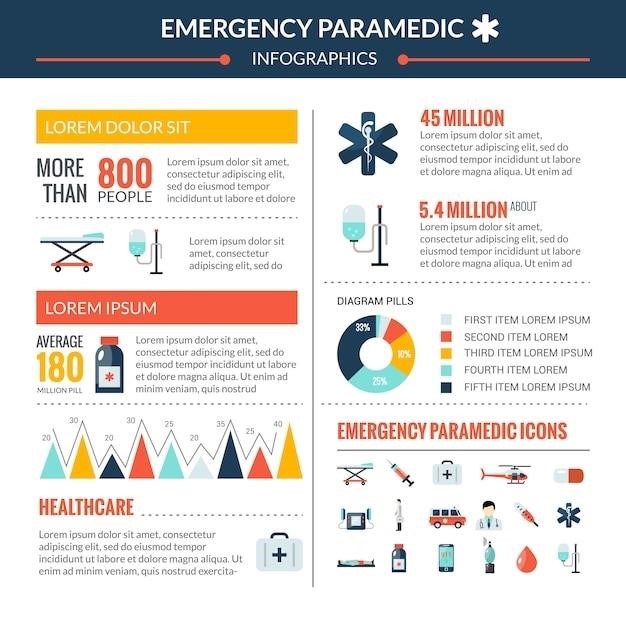Paramedic Practice Scenarios⁚ A Comprehensive Overview
Paramedic practice scenarios are crucial for effective training. They range from simple to complex‚ mirroring real-world emergencies. These scenarios enhance decision-making skills and preparedness in pre-hospital care‚ improving patient outcomes. Access to diverse scenarios‚ whether pre-made or custom-designed‚ is vital for comprehensive training.
Types of Paramedic Scenarios and Their Applications
Paramedic practice scenarios encompass a wide spectrum of medical emergencies and situations‚ each designed to test specific skills and knowledge. Trauma scenarios‚ ranging from motor vehicle accidents to falls‚ assess the paramedic’s ability to manage injuries‚ prioritize treatment‚ and make rapid critical decisions under pressure. Cardiac arrest scenarios focus on resuscitation techniques‚ airway management‚ and the administration of life-saving medications. Respiratory distress scenarios‚ including asthma attacks and anaphylaxis‚ challenge the paramedic’s understanding of respiratory physiology and the appropriate application of interventions; Neurological emergencies‚ such as strokes and seizures‚ require quick assessment and the implementation of specific protocols. Furthermore‚ scenarios involving patients with altered mental status test the paramedic’s ability to identify underlying causes and provide appropriate care. These diverse scenarios are invaluable for developing proficiency across the full range of paramedic skills. Each scenario type serves a distinct purpose‚ contributing to a well-rounded and comprehensive training program. The use of progressively challenging scenarios ensures that paramedics develop the confidence and expertise to handle any situation they might encounter in the field.
Scenario Development and Progression in EMT Training
Effective EMT training relies heavily on the strategic development and progressive implementation of realistic scenarios. Initial scenarios typically focus on fundamental skills‚ such as basic life support‚ scene assessment‚ and patient communication. As trainees progress‚ scenarios increase in complexity‚ introducing multiple patients‚ challenging environments‚ and ethical dilemmas. The incorporation of high-fidelity simulation‚ often using manikins that mimic real-life physiological responses‚ significantly enhances the realism and effectiveness of training. This approach allows trainees to practice procedures repeatedly in a safe environment‚ building confidence and competence. The progression of scenarios isn’t solely about increasing difficulty; it’s also about introducing new concepts and integrating previously learned skills into more complex situations. For example‚ early scenarios might focus on individual trauma injuries‚ while later scenarios incorporate multiple trauma injuries and the need to prioritize care. Regular feedback and debriefing sessions after each scenario are crucial for identifying areas for improvement and reinforcing learning. This iterative process of scenario development and refinement ensures that EMTs are adequately prepared for the diverse range of emergencies they will face in practice.
Utilizing Paramedic Practice Scenarios in Education
Paramedic practice scenarios are invaluable educational tools‚ offering a bridge between theoretical knowledge and practical application. They provide a safe‚ controlled environment to practice critical thinking‚ decision-making‚ and teamwork skills. Scenarios can be tailored to specific learning objectives‚ allowing instructors to focus on particular aspects of pre-hospital care‚ such as trauma management‚ cardiac arrest response‚ or medication administration. The use of standardized patients‚ who act as realistic patients‚ further enhances the training experience by adding a human element and allowing trainees to practice communication and interpersonal skills. Technology plays a significant role in modern scenario-based learning. High-fidelity simulation‚ virtual reality‚ and augmented reality tools create immersive environments‚ mirroring the complexities and pressures of real-life emergency situations. Effective scenario design incorporates a debriefing phase‚ allowing instructors to provide constructive feedback and facilitate reflective learning. This process helps trainees identify areas for improvement‚ understand the rationale behind their actions‚ and develop a deeper understanding of patient care. The integration of scenarios into paramedic education strengthens clinical skills‚ improves teamwork‚ and ultimately leads to better patient outcomes.

Resources for Paramedic Practice Scenarios
Numerous resources exist for accessing paramedic practice scenarios. Pre-made scenario banks offer readily available materials‚ while custom creation allows tailoring to specific needs. Online platforms and textbooks provide valuable resources for both approaches.
Accessing and Utilizing Pre-made Scenario Banks
Pre-made scenario banks offer a convenient and efficient method for accessing a wide variety of paramedic practice scenarios. These banks often provide a structured collection of scenarios categorized by difficulty‚ patient presentation‚ or specific medical conditions. This organization allows instructors to select scenarios tailored to their specific training objectives‚ ensuring that the learning experience aligns with the curriculum. Many pre-made scenario banks are available online through professional organizations‚ educational institutions‚ or commercial vendors. These online resources offer easy access and often include supplementary materials such as answer keys‚ debriefing guides‚ and additional learning resources to further enhance the educational experience. The ease of access and the readily available supplementary materials make pre-made scenario banks an incredibly useful tool for paramedic training programs.
The use of pre-made scenarios can significantly streamline the process of curriculum development and implementation. Instructors can save valuable time and resources by utilizing these pre-designed materials‚ allowing them to focus on other critical aspects of instruction‚ such as providing effective feedback and facilitating engaging debriefing sessions. Furthermore‚ pre-made scenarios often incorporate best practices and current guidelines in prehospital care‚ ensuring that the training is up-to-date and reflects current standards of practice. However‚ it’s important to critically evaluate the quality and relevance of pre-made scenarios to ensure they align with the specific needs and learning objectives of the program. Careful selection of scenarios is key to maximizing their effectiveness in enhancing the skills and knowledge of paramedic students.
Creating Custom Paramedic Scenarios⁚ A Step-by-Step Guide
Developing bespoke paramedic scenarios offers unparalleled flexibility in tailoring training to specific needs. Begin by defining clear learning objectives; what skills or knowledge should the scenario reinforce? Next‚ establish the scenario’s context⁚ location‚ patient demographics (though often omitted for broader application)‚ and presenting complaint. Construct a detailed patient history‚ incorporating relevant medical information‚ including past medical history‚ current medications‚ and allergies. Remember to include vital signs and physical assessment findings consistent with the chosen presentation. Develop a realistic progression of events‚ incorporating potential complications and requiring critical decision-making points from the trainee. The scenario should present ethical dilemmas and necessitate prioritization of care.
Incorporate realistic challenges‚ such as limited resources or difficult environmental conditions‚ to enhance the simulation’s authenticity. After drafting the core scenario‚ create supplementary materials⁚ dispatch information‚ witness statements‚ and relevant lab results. Finally‚ develop a comprehensive debriefing guide to analyze the trainee’s performance‚ focusing on both correct and incorrect actions. This structured approach ensures a high-quality‚ targeted learning experience. Remember to regularly review and update your custom scenarios to reflect advancements in medical knowledge and best practices. Consider using feedback from participants to enhance future scenarios. This iterative process ensures scenarios remain relevant and effective in preparing paramedics for the realities of pre-hospital care.

Analyzing Paramedic Practice Scenarios
Post-scenario debriefing is critical. Analyzing critical decision points and their consequences helps identify areas for improvement in knowledge and skills. Reflective practice‚ facilitated by structured debriefing‚ enhances learning and improves future performance in emergency situations.
Critical Decision Points and Their Implications
Effective analysis of paramedic practice scenarios hinges on identifying critical decision points. These are moments where the paramedic’s choices significantly impact patient outcomes. For instance‚ in a trauma scenario‚ the decision to rapidly intubate versus using a less invasive airway management technique could be crucial‚ depending on the patient’s condition and available resources. Similarly‚ in a cardiac arrest scenario‚ the choice of which medication to administer first‚ or whether to initiate CPR immediately versus defibrillation‚ can determine survival. Analyzing these decisions requires careful consideration of the patient’s presentation‚ the paramedic’s knowledge base‚ the available resources‚ and the time constraints inherent in emergency situations. The implications of each decision must be explored thoroughly‚ considering both the potential benefits and risks. Did the chosen intervention lead to a positive outcome? Could another approach have yielded better results? What were the underlying factors influencing the decision-making process? A thorough understanding of these implications is key to enhancing clinical judgment‚ improving decision-making skills‚ and ultimately providing the highest quality prehospital care.
Post-Scenario Debriefing and Reflective Practice
Post-scenario debriefing is an essential component of effective paramedic training using scenarios. This structured process allows for a thorough review of the scenario‚ focusing on both the technical aspects of care and the decision-making processes involved. Participants should actively participate in a facilitated discussion‚ analyzing their actions and identifying areas for improvement. Constructive feedback from instructors and peers is crucial to foster a learning environment. Reflective practice encourages self-assessment and critical thinking. By analyzing the rationale behind their choices‚ paramedics can identify strengths and weaknesses in their clinical judgment. This process extends beyond immediate feedback; it encourages continuous professional development. Paramedics should reflect on their experiences‚ both positive and negative‚ to identify areas where they can refine their skills and knowledge. This continuous cycle of learning‚ improvement‚ and reflection is vital to ensure competence and preparedness in the demanding field of pre-hospital emergency medicine. The use of written or recorded reflections can further enhance this process‚ providing a tangible record of learning and growth.
